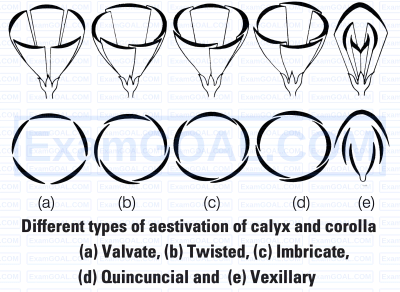Differentiate between
(a) Bract and bracteole (b) Pulvinus and petiole (c) Pedicel and peduncle (d) Spike and spadix (e) Stamen and staminoid (f) Pollen and pollenium
(a) Bract and Bracteolate Bract is a leaf like structure in the axil. i.e., at the base of which flowers are borne. They can be small or scaly, green and coloured and usually single, whereas bracteolate are bract like structures borne on the stalk of a flower.
(b) Pulvinus and Petiole Pulvinus is the leaf base, which is the proximal swollen region with which a leaf is attached to the stem. Petiole is cylindrical or sub-cylindrical stalk which connects the leaf base with the lamina.
(c) Pedicel and Peduncle The stalk of a flower is known as pedicle, whereas the stalk of whole inflorescence is known as peduncle.
(d) Spike and Spadix In spike inflorescence, the flowers are sessile that develop on an elongated peduncle in acropetal succession, e.g., Adhatoda. The peduncle is non-fleshy. The spadix inflorescence is like spike, but it is covered by one to a few large bracts called spathes, e.g., Colocasia. The peduncle is fleshy and its optical portion is naked, i.e., without flowers.
(e) Stamen and Staminoid The male reproductive organs or microsporophylls of a flower are called stamen. A fully sterile under developed or abrtive stamen is called a staminoid, e.g., Verbascum.
(f) Pollen and Pollinium Microspore of an angiospermic flower is known as pollen. It is haploid, whereas a mass of pollen grains from the same anther constitute the pollinium as in Calotropis.
Distinguish between families - Fabaceae, Solanaceae, Liliaceae on the basis of gynoecium characteristics (with figures). Also write economic importance of any one of the above family.
The difference between the three families on the bases of charateristics of hynoecium are as follows
| Gynoecium Characteristics | Fabaceae | Solanaceae | Liliaceae |
|---|---|---|---|
| Carpels | Monocarpellary free, single | Bicarpellary Syncarpous | Tricarpellary syncarpous |
| Ovary | Superior unilocular | Superior bilocular (2-4 locular in tomato) | Superior |
| Ovules | Margin in two alternate rows | Many in each locular | Trilocular |
| Palcentation | Marginal | Axile | 2-many ovules in each locules |
| Style | Bent, single | Simple | Simple but may be united or separate |
| Stigma | Simple and capitate | Simple and lobe | Free or fused trilobed |
| Floral formula | $\begin{aligned} & \mathrm{Br} \% \quad \mathrm{~K}_{(5)} \mathrm{G}_{1+2+(2)} \\ & \mathrm{A}_{1+(9)+1} \underline{G}_1\end{aligned}$ | $-\mathrm{Br} \oplus \mathrm{K}_{(5)} \mathrm{G}_5 \mathrm{~A}_5 \underline{\mathrm{G}}_{(2)}$ | $\mathrm{Br} \oplus \mathrm{P}_{3+3} \mathrm{~A}_{3+3} \underline{\mathrm{G}}_{(3)}$ |
| Gynoecium Characteristics | Fabaceae | Solanaceae | Liliaceae |
|---|---|---|---|
| Diagram of gneoecium |  |
 |
 |
| Floral diagram |  |
 |
 |
| Examples | Garlic, onion, Colchicum | Potato, tomato, brinjal, datura, etc | All pulses, sunhemp, Lupin, Indigo, Cassia |
Economic Importance of Fabaceae
Plants of this family are the sources of pulses and edible oils. Dye is extracted from Indigofera which is a plant of this family. It serves as a source of various other products like fibres (sunnhemp), facter (Sesbania and Trifolium), ornamentals (lupin, sweet pea) and medicine (multiathi).
The various stem modifications are as follows
| Stem | Modification of Stem for Storage of Food |
|---|---|
| Rhizome | In this case the stem becomes underground and grows horizontally, stores food material. It bears nodes, internodes and buds which give rise to aerial shoots, e.g., ginger, banana, turmeric.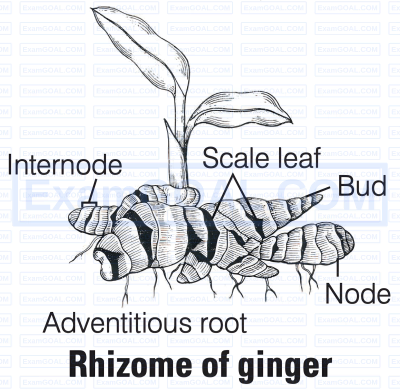 |
| Corn | Stem is underground, grows vertically and bears nodes as well as internodes e.g. Colocasia.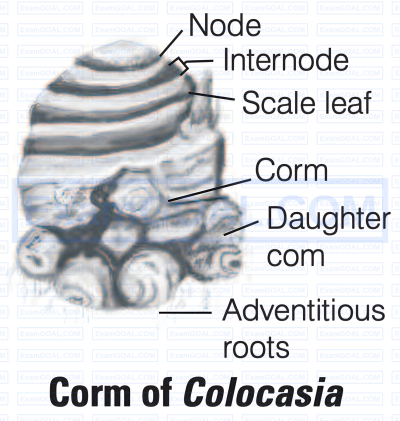 |
| Bulb | In this case, the stem becomes underground, the internode is shortened in such a way that the leaves are condensed and these leaves become thick and fleshy and store food material e.g.,-onion.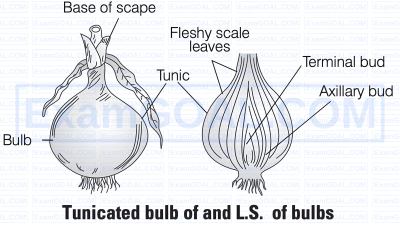 |
| Tuber | This is also a special kind of stem modification, which arises at the tips of special narrow underground branches. They have nodes, internodes apical buds, scale leaf in the form of ridge. They gave no. of eyes which represent nodes. It is meant for storing food material, e.g., potato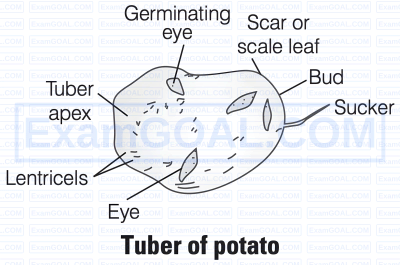 |
| Stem tendrils | Modification of Stems for Climbing These are found in cucurbits and grapevine. The axillary buds of the stem become elongated and spirally coiled and twine around a support for the plant to grow as the stem is weak and herbaceous. |
| Stem thorns | Modification of Stem for Protection These are present in the axil of leaf or apex of stem performing the function of either climbing or defence, e.g., Duranta, Calamus and also reduce transpiration. |
Stem modifications Stem gets modified in different forms like stolon, offset and rhizomes. These can be distinguished from each other in the following manner
| Storm | Offset | Rhizome |
|---|---|---|
The stem is a creeper. It is a long distance runner with longer and thicker internodes. Horizontal branches arise from the internodes, e.g., strawberry Colocaica.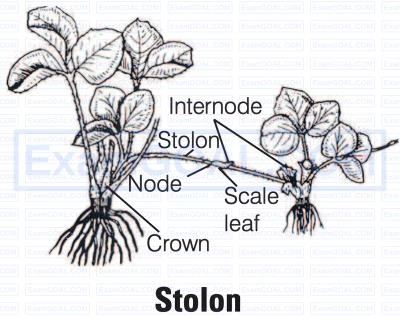 |
It is like small a runnes of one internode long, but inter nodes are shorter and thicker branches arise all around the main stem usually found in rosette plants on water or ground surface. e.g., Eichhornia, Pistia.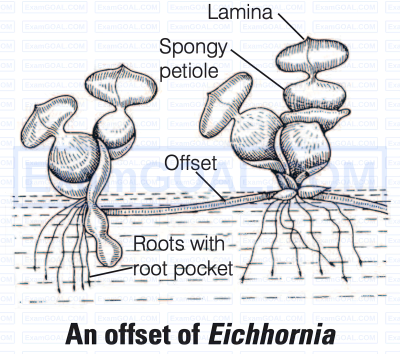 |
These are stem which bear nodes and internodes, scaly leaves, axillary buds and roots arising from nodes e.g., Ginger, banana, turmeric. They are modified to store food in plants.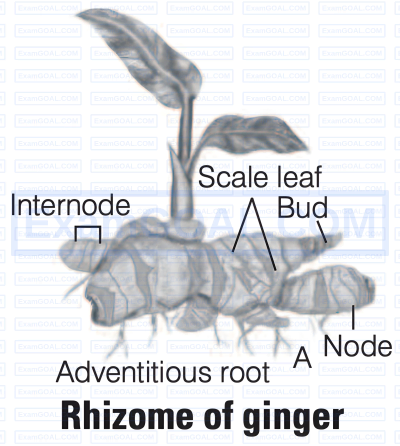 |
The mode of arrangement of petals or sepals in a flower bud with respect to the members of the same whorl or with each other is known as aestivation. It is of following types Valvate Margin of adjacent petals or sepals touch each other, but do not overlap, e.g., mustard (Brassica).
Twisted Regular overlapping of petals or sepals occurs in which margin of one petal overlap with the adjacent next one petal, e.g., China rose (Hibiscus rosa sinensis).
Imbricate There are five petals arranged in such a way that one petal is completely external and one petal is completely internal, three petals are partially external and partially internal, e.g., Cassia, Callistemon, Caesalpinia.
Quincuncial There are five sepals or petals of which two are completely out and two are completely inside, while one is partially out and partially in e.g., Cucurbita (Cucurbitaceae). Vexillary It is the characteristic aestivation of corolla of family - Papilionaceae, in which corolla (petals) are papilionaceous.
The largest petal overlap the two lateral petals (wings), which in turn overlap the two smallest anterior petals (keel) e.g., Artobotrys, Polyalthea, Pisum.
